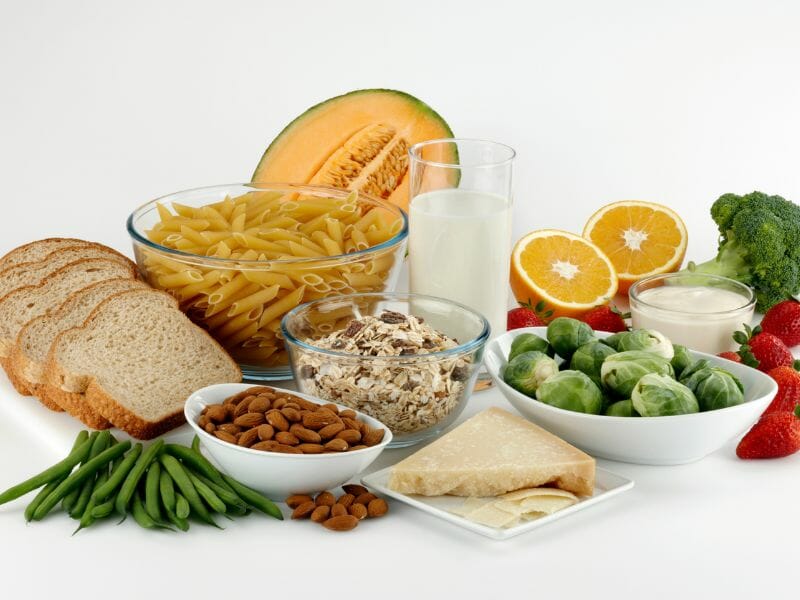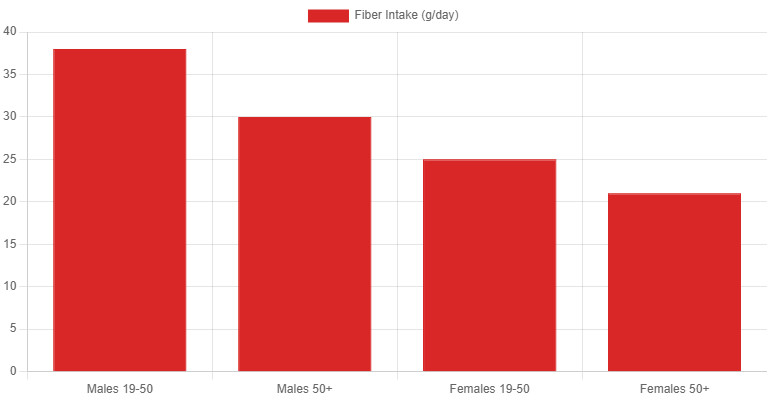Meeting your recommended fiber intake by age? Discover the life-changing benefits.
What is the recommended fiber intake for your age/gender?
👍The recommended fibre intake, for adult men is 38 grammes, while for women it is 25 grams. The suggested fibre per day intake is 30 grammes for men over 50 and 21 grammes for women over 50. The recommended fibre intake, for adult men is 38 grammes, while for women it is 25 grams. The suggested fibre per day intake is 30 grammes for men over 50.The recommended fiber intake for women over 50 is 21. Fiber recommendations by age and gender per day are different for kids and teenagers.
Table of Contents
Fruits, vegetables, legumes, and whole grains are examples of plant-based diets that are high in fiber. They are an essential component of a balanced diet since they aid in maintaining a healthy weight and regulating digestion.

Fiber is a carbohydrate found in plant-based foods such as fruits, vegetables, legumes, and whole grains. It is an important part of a healthy diet since it promotes digestion and weight management. The fiber intake recommendations varies based on age, gender, and other factors, such as physical activity level.
The top health benefits of a high-fiber diet
Improve blood sugar levels: Consuming fiber can improve blood sugar by slowing down glucose absorption, maintaining constant levels. A high-fiber diet can also lower the risk of type 2 diabetes by enhancing insulin sensitivity, essential for regulating sugar levels. To manage blood sugar and prevent diabetes, include a variety of high-fiber foods in your diet. Meeting the recommended fiber intake can also improve blood sugar control in people with diabetes.
Regulate bowel movements: Some people may need to exceed the recommended fiber intake, such as those with certain medical conditions like irritable bowel syndrome. Fiber intake helps to regulate movements of bowel by adding bulk to the stool and increasing its weight. This helps to stimulate the muscles of the intestine, which helps move the stool through the digestive tract more efficiently. In addition, fiber helps to absorb water in the intestine, which can help to soften the stool and make it easier to pass.
Fiber in weight management and weight loss: By decreasing hunger and increasing feelings of fullness, fibre can help with weight control and loss. Fiber-rich foods are more satisfying and can keep you fuller for longer periods of time, which can help you control cravings and minimise overeating. Furthermore, high-fiber foods contain less calories, which can aid in weight loss.
Link between high fiber diets and other potential health benefits: High-fiber diets may provide additional health benefits. According to several studies, high-fiber diets may be related to a lower risk of some types of cancer, particularly colon cancer. This could be because fibre aids in the removal of waste and poisons from the body more efficiently. Furthermore, fibre may help shorten the amount of time hazardous compounds remain in the colon, potentially lowering the risk of colon cancer.
One way fibre may help protect against these illnesses is by lowering cholesterol levels. Soluble fiber, in particular, has been proven to bind with cholesterol in the digestive system and aid in its removal from the body, potentially lowering total blood cholesterol levels.
What are foods full of fiber
Vegetables: Eating high-fiber plant foods are a crucial component of a healthy diet because they offer a variety of nutrients, such as vitamins, minerals, and antioxidants. These nutrients can support weight management, improve digestive health, and possibly lower the risk of certain medical conditions, such as heart disease, stroke, and some types of cancer.
The following foods are high in fibre and offer a variety of nutrients that can support general health: fresh and raw vegetables like kale, spinach, broccoli, Brussels sprouts, cauliflower, and cabbage; squash such as acorn and butternut squash; root vegetables such as sweet potatoes, turnips, and beets; and legumes such as beans, lentils, and peas.
Beans, lentils, and rice: Incorporating enough fiber into your diet can be beneficial for overall health. Legumes with fewer calories like beans (kidney beans, green beans, chia seeds, green peas etc.) and lentils are among the highest-fiber foods you can eat.
In addition to being high in fiber, beans, lentils as well as grain products and whole wheat flour are also a good source of protein, vitamins, and minerals, and can be used in a variety of dishes, such as soups, stews, salads, and rice dishes. Whole wheat flour, brown rice and quinoa are also good sources of fiber, with one cup of cooked brown rice providing about 3.5 grammes of fiber and one cup of cooked quinoa providing about 5 grammes of fiber.
Fruits with a lot of fibre: Fruits are a fantastic source of fibre when they are fresh, and many varieties that have a lot of fibre per serving. For instance
- Apples: A medium apple that still has its peel on has roughly 4 grammes of fibre.
- Berries: Strawberries, raspberries, and blackberries; one cup of raspberries has around 8 grammes and one cup of blackberries has about 7.6 grammes of fibre, respectively.
- Pears: 5.5 grammes of fibre can be found in one medium pear, skin on.
- Avocados: A medium avocado has 6.7 grammes of fibre.
- Dried fruits: With roughly 3 to 4 grammes of fibre per serving, dried fruits like figs, apricots, and prunes are similarly high in fibre.
Citrus : Fruits and juices high in fiber including oranges, orange juice, grapefruits, tangerines – each fruit containing about 3 grammes of fiber.
what is the general recommended dietary fiber intake for men, women and children?
The grams of fiber per day varies by age and gender. The Institute of Medicine recommends the following fiber needs by age and gender:
- Fiber intake for males aged 19 to 50: 38 g/day
- Men over the age of 50: 30 g /day
- Fiber intake for females aged 19 to 50: 25 g/day
- recommended daily fiber intake for women over 50: 21 g/day

The recommended daily fiber intake for children and adolescents varies according to age and gender. To establish the recommended fiber intake by age for children and adolescents, utilise this online tool:
https://nutrareviews.org/fiber-intake-calculator/
What fiber supplements are recommended?
Fiber supplements come in a range of forms like powders, capsules, and chewable pills. Examples of dietary supplements having fibre include:
Psyllium: This kind of soluble fibre supplement is made from the plantain plant’s seeds. Constipation is frequently treated with it, and it might also lower cholesterol levels.
Methylcellulose: This particular variety of soluble fibre is made from cellulose from plants. Constipation is frequently treated with it, and it might also lower cholesterol levels.
Inulin: This particular kind of soluble fibre comes from the roots of plants like chicory. It is frequently used as a prebiotic to aid in the growth of advantageous microorganisms in the gastrointestinal tract.
Polydextrose: This kind of soluble fiber, which is created from glucose, is frequently employed as a low-calorie sweetener and food bulking agent.
Guar gum: This particular variety of soluble fibre comes from the guar plant’s seeds. It is frequently employed as a food thickener and could aid in lowering cholesterol levels.
Overall, consuming the recommended fiber intake is crucial for maintaining good health and preventing chronic diseases.
FAQs
What kind of bread is high in fiber?
Choose whole-grain baked products like whole-wheat bread, oat bran, oatmeal bread or muffins, multigrain bread, graham crackers, and whole-wheat bagels. Replace refined white bread with whole-grain breads and cereals.
How much fiber a day do you need for healthy poop?
The amount of fiber needed for a healthy and regular bowel can vary depending on a person’s age, gender, and individual digestive system. Meeting the recommended fiber intake can help regulate digestion and prevent constipation. In addition, it is important to drink plenty of water when increasing dietary fiber intake to help fiber move through the digestive system more easily.
Which bread is highest in fiber?
There are many types of bread that are high in fiber. Here are a few examples:
Whole grain bread: Bread made from whole grains, such as whole wheat, oats, or rye, is generally higher in fiber than bread made from refined grains. One slice of this bread can provide about 2-4 grams of fiber.
Sprouted grain bread: This type of bread is made from whole grains that have been sprouted, which can increase the amount of fiber in the bread. One slice of such bread can provide about 3-5 grams of fiber.
Sourdough bread: Some types of sourdough bread are made with whole grain flour, which can increase the fiber content. One slice of sourdough bread made with whole grain flour can provide about 2-3 grams of fiber.
Flaxseed bread: Bread made with flaxseeds is a good source of fiber, as flaxseeds are high in fiber. One slice of flaxseed bread can provide about 2-3 grams of fiber.
What is a high fiber diet?
A high-fiber food is when you eat a lot of foods that have a special type of carbohydrate called fiber. Fiber aids in a variety of bodily functions, including assisting with bowel movements and maintaining appropriate levels of cholesterol and blood sugar. You should consume a lot of fruits, vegetables, whole grains, nuts and seeds to maintain a diet high in fiber.
The recommended fiber daily needs by age and gender for adults should consume at least 25 grammes. Consuming a lot of fiber might help you maintain a healthy weight, improve the function of your digestive system, and possibly even reduce your chance of contracting certain diseases like cancer and heart disease.
How do I know if I am taking too much fiber?
Consuming too much fibre can result in digestive problems like gas, bloating, and pain in the abdomen. Further more, high-fiber diets or supplements may alter bowel habits and may prevent the absorption of several drugs.
It is a good idea to consult a healthcare professional or a qualified dietitian for advice on the right quantity of fibre for your particular needs if you are experiencing any of these symptoms or are worried about your fibre consumption or think that you are exceeding the recommended fiber intake.
How much fiber is recommended daily for optimal digestive health?
According to the Dietary Guidelines for Citizens of America, the recommended daily ingestion of dietary fiber is 14 grams per 1,000 calories consumed. As for the average adult, this equates to approximately 25 grams for the female gender and 38 grams for the male gender daily.
Nevertheless, the demand for fibre recommendations is subject to personal needs which may vary based on particular factors such as age, gender, and activity level. It is always judicious to confer with a medical professional to ascertain the appropriate quantity of dietary fiber necessary for one’s specific needs.
How much fiber should I consume daily to promote weight loss and maintain a healthy diet?
The suggested measure of fiber one must consume every day to promote weight loss is approximately 25-30 grams per day. This quantity is recommended as it helps to induce a sense of satiety that lasts for a longer period of time and can be instrumental in regulating one’s appetite.
Nevertheless, it is of paramount importance to ensure that one adheres to a well-rounded diet and participates in consistent physical activity to facilitate effective weight management.








